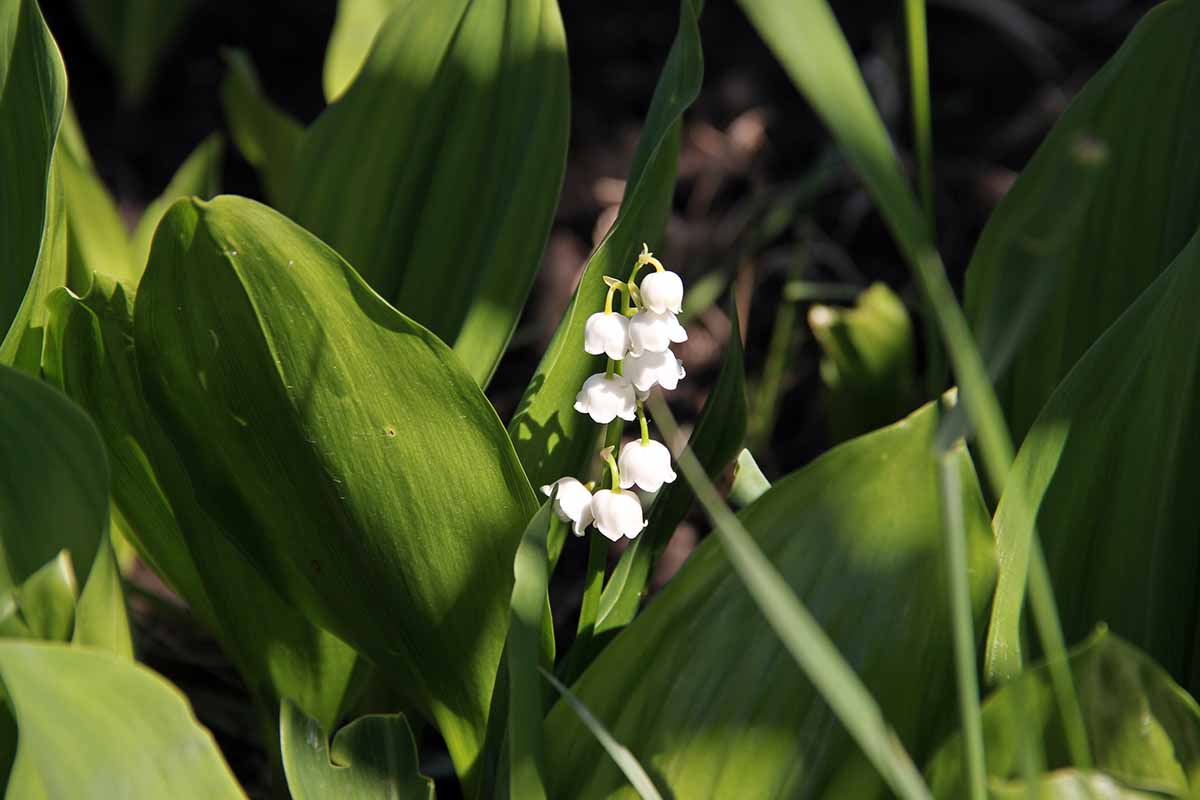A prized planting for shady sites, lily of the valley makes a beautiful, cool green ground cover with small spires of tiny, bell-shaped flowers and a delightful perfume.
An easy care perennial, the pretty creamy white or pink flowers appear readily when just a few specific growing conditions are met: a shady setting, moist soil when the plant is setting buds, and adequate space for the roots to spread freely.
We link to vendors to help you find relevant products. If you buy from one of our links, we may earn a commission.
Give them what they like and you’ll enjoy a beautiful carpet of adorable, fragrant flowers. But if something is amiss, the plant may fail to flower.
Affected by very few disease or pest problems, they spread fast in optimal conditions. The thick, fleshy roots quickly fill in beds and plants come back fuller every year.
If left to grow unchecked, lily of the valley plants quickly form a handsome ground cover that effectively chokes out weeds.
To grow into vibrant plants with plenty of flowers, lily of the valley needs partial shade, consistent moisture, and loose soil with a slightly acidic pH of 6.0 to 6.5.
While C. majalis has a well-earned reputation for being tough and reliable, problems like root rot can arise if they’re planted in overly wet soil – a well-draining environment is a must for healthy plants.
As light feeders, a one- or two-inch layer of compost in early spring meets all their nutritional requirements.
For more information about how to cultivate lily of the valley, our growing guide has all the planting and care details.
Flowering in spring amid lush foliage, plants go dormant in fall and during winter, but can remain evergreen in areas with mild winters.
They have excellent cold hardiness and are suitable for planting in USDA Zones 2 to 9, but in hot weather the plants tend to shrivel and die back.
If your plants aren’t producing flowers, it’s likely that there’s something amiss in their growing environment. It’s usually easy to solve the issue and they’ll provide you with plenty of blooms next year!
Lily of the valley is a treasured shade garden plant that produces delightful, fragrant spring flowers. But when your lily of the valley refuses to bloom, it can be disappointing to just have the greenery and no flowers
The good news is that it’s usually an easy fix to get your lily of the valley blooming abundantly again. Here are the most common reasons why lily of the valley may fail to flower and what to do to enjoy those pretty bells next spring.
Reasons Why Lily of the Valley Won’t Bloom
1. Immature Plants
Lily of the valley can take a year or two to become established before flowering. If you have newly planted lily of the valley with no blooms, be patient. Make sure it has the right growing conditions and flowering should follow in subsequent years as the plants mature.
2. Lack of Sun
While lily of the valley thrives in shade, it does need a few hours of morning sun to support prolific flowering Ensure plants get some early light but avoid hot afternoon sun. Dappled sunlight filtering through trees is ideal Too much shade prevents bud development.
3. Insufficient Water
Lily of the valley prefers consistently moist soil. If the bed gets too dry, especially when buds are forming, it will reduce flowering. Drought stress inhibits the plant’s ability to bloom. Water deeply once a week if rain is lacking.
4. Overcrowding
The fast-spreading roots can become overcrowded, which impedes flowering. Every 3-5 years, lift and divide congested clumps in fall. Replant divisions with plenty of space to grow.
5. Compacted Soil
Dense soil prevents proper air circulation and drainage. It also makes it hard for the roots to spread. Use a garden fork to loosen and aerate the bed in late winter.
How to Get Lily of the Valley to Bloom Again
- Provide morning sunlight and afternoon shade
- Water weekly if soil gets dry when buds are forming
- Divide congested plants every few years
- Loosen compacted soil with a garden fork
- Mulch plants to maintain consistent moisture
- Be patient with new plantings to allow maturity
A little tweaking of the growing conditions is often all that’s needed to get lily of the valley blooming happily again. Pay attention to sunlight, soil moisture, and preventing overcrowding. With the right care, the sweet spring flowers will return.
/beautiful-lily-varieties-to-grow-4136203-3-ecb49980016c4a498a90d6c379307ddd.jpg)
Too Much Light
For an abundance of flowers, lily of the valley needs to grow in the shade.
A few hours of early morning sunshine is fine, but for most of the day it needs the cooler temperatures of shady locations to develop a profusion of blooms.

And when the plants receive too much sunshine, bud set may not happen.
To ensure ample bud set, provide plants with part to full shade from about 10 o’clock in the morning onwards, to avoid hot afternoon sun.
When new plantings fail to bloom, it could be that they’re simply not mature enough to flower yet.

Generally, after planting it can take new stock up to two years to start blooming.
In the meantime, ensure they have optimal conditions for vigorous growth and be patient, when they’re well-established, flowers will follow.
Solving Lily of the Valley Growing Problems Like a Pro
FAQ
Why didn’t my lilies of the valley bloom?
️ Common Culprits Behind Blooming Woes
Aim for a dappled shade environment that mimics their natural woodland habitat. Temperature swings can also throw your plant off its game. Lily-of-the-Valley prefers consistent conditions, so avoid placing it in spots where temperatures fluctuate wildly.
How to make lily of the valley bloom?
Plant the pips in a moist well-drained potting mix with the tips just visible above the soil. Place the container in a bright location, watering often enough to keep the soil moist, but not wet. Continue to water and wait for the flowers to appear in 3 to 4 weeks. Remove flower stems as the flowers fade.
How many years does it take for lily of the valley to bloom?
Lily of the valley typically takes two years to flower when planted bareroot. You can also score big bargains on lily of the valley by purchasing potted plants in summer or early fall, when plants aren’t flowering.
What to do when lilies don’t bloom?
